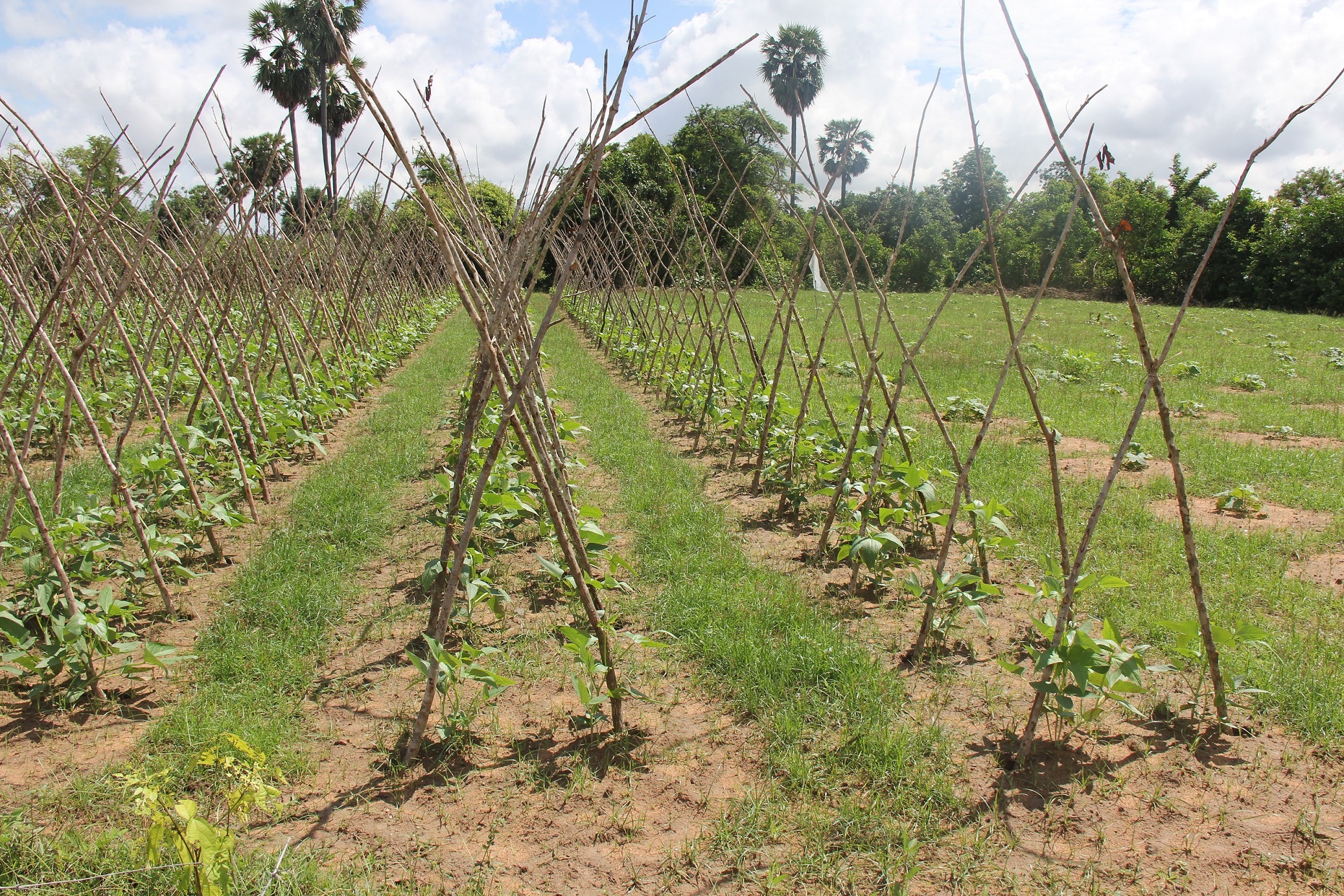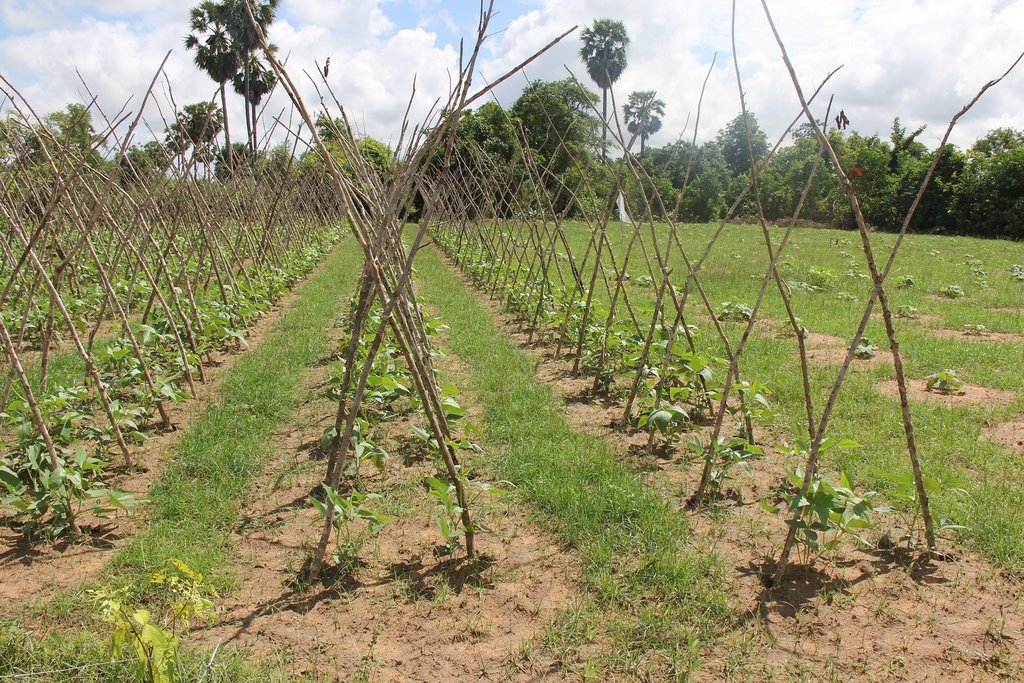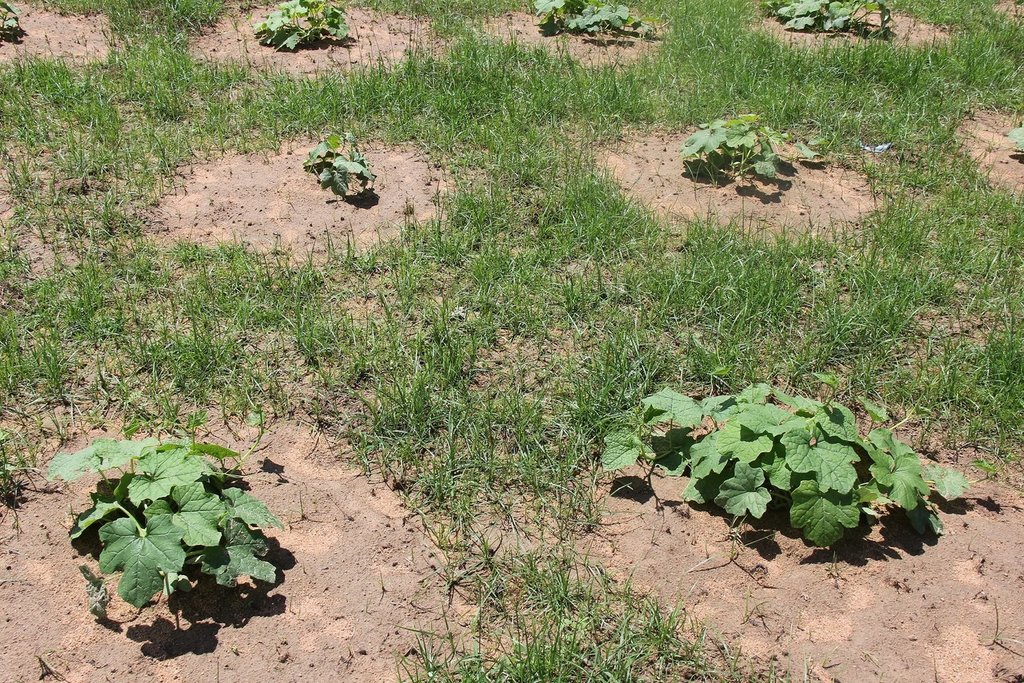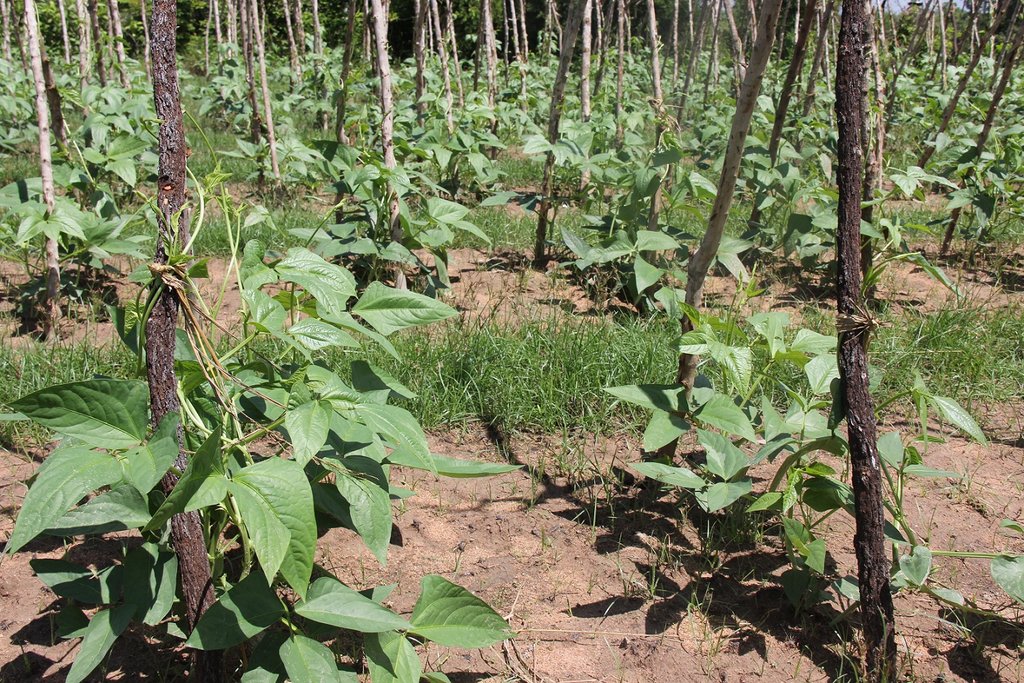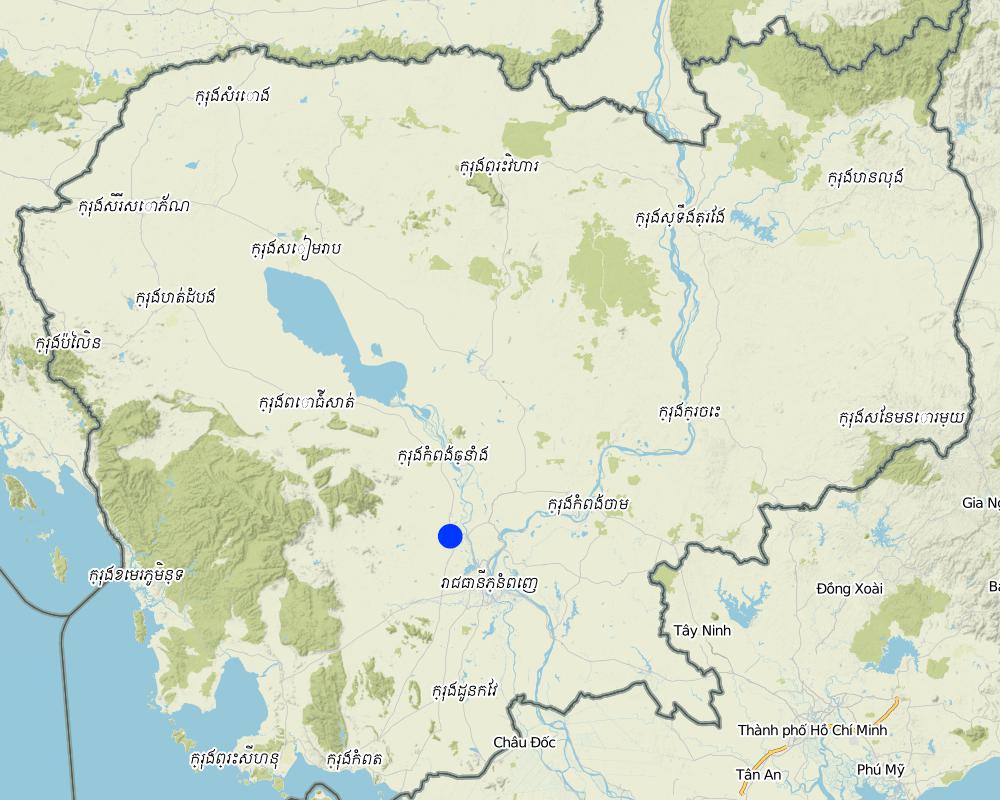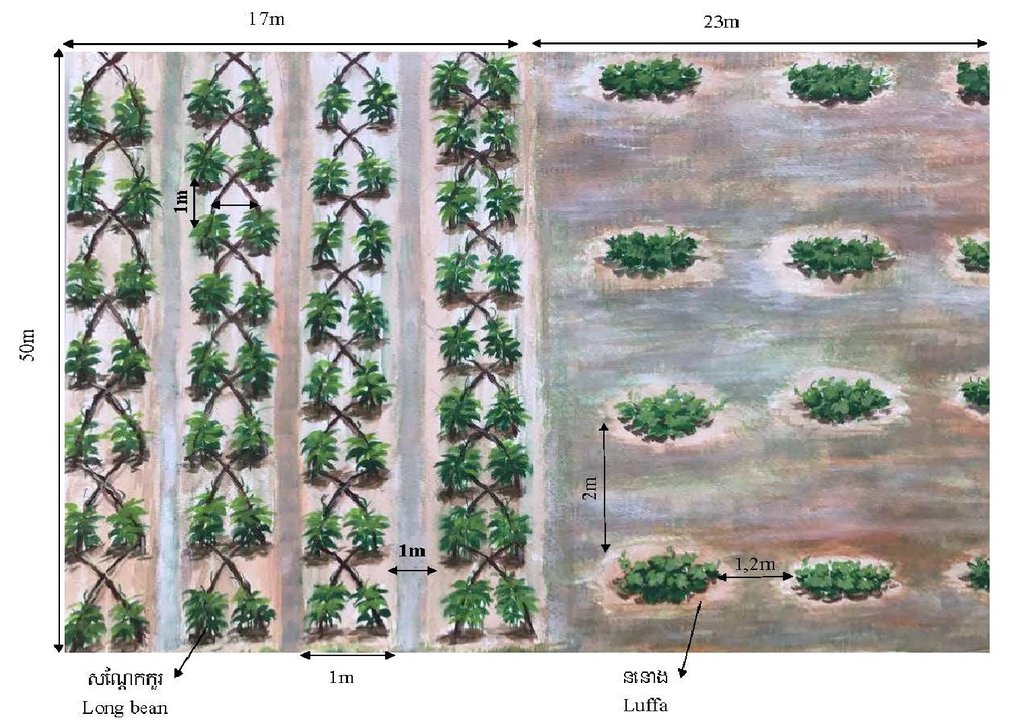Crop rotation to promote safe vegetables [Cambodia]
- Creation:
- Update:
- Compiler: Be Gechkim
- Editors: Navin Chea, Sophea Tim
- Reviewers: SO Than, Nicole Harari
Safe Vegetable
technologies_3165 - Cambodia
View sections
Expand all Collapse all1. General information
1.2 Contact details of resource persons and institutions involved in the assessment and documentation of the Technology
Key resource person(s)
land user:
Chanthou Ek
(+855) 69 40 65 50
N/A
Farmer
Kyang Tboung village, Svay commune, Samekki Mean Chey district, Kampong Chhnang
Cambodia
Vice Chief of Agricultral Extension Office of Provincial Department of Agriculture, Forestry and Fisheries, Kampong Chhnang Province:
Chief of Agricultural Office of Tuek Phos District:
Vice Chief of Agronomy Office of Rolea B'ier District:
Bunleang Chhim
(+855) 77797324
N/A
Office of Agricultural of Rolea B'ier District
Prey Puoch village, Chrey Bak commune, Rolea B'ier District, Kampong Chhnange province.
Cambodia
Name of project which facilitated the documentation/ evaluation of the Technology (if relevant)
Scaling-up SLM practices by smallholder farmers (IFAD)Name of the institution(s) which facilitated the documentation/ evaluation of the Technology (if relevant)
Royal University of Agriculture (RUA) - Cambodia1.3 Conditions regarding the use of data documented through WOCAT
When were the data compiled (in the field)?
25/05/2017
The compiler and key resource person(s) accept the conditions regarding the use of data documented through WOCAT:
Yes
1.4 Declaration on sustainability of the described Technology
Is the Technology described here problematic with regard to land degradation, so that it cannot be declared a sustainable land management technology?
No
Comments:
Farmer cultivate a variety of crops and change row destination.
1.5 Reference to Questionnaire(s) on SLM Approaches
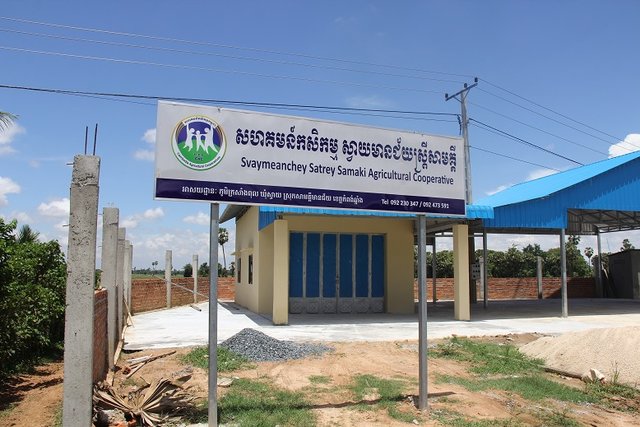
A Safe Vegetable Growers Group in the Svaymeanchey … [Cambodia]
The safe vegetable growers group was formed by farmers on a voluntary basis and is part of an Agricultural Cooperative. It supports the selling of products through an organized group to buyers. The producers and the buyers have to sign a contract as the main agreement and with set principles. …
- Compiler: Navin Chea
2. Description of the SLM Technology
2.1 Short description of the Technology
Definition of the Technology:
Crop rotation is a component of integrated pest management (IPM) which can contribute to an improvement in crop production with a standardized and reduced use of chemical fertilizers and pesticides.
2.2 Detailed description of the Technology
Description:
Crop rotation is the process of regularly alternating crops on a seasonal basis on the same plot of land. One of the benefits is that nutrients and nitrogen will be transferred to the soil through this practice as traditionally green manure is added when crops are alternated with cereals. The practice helps to reduce the manifestation of diseases and insects that often occur when crop cultivation is repeated over a prolonged period. Crop rotation can improve the soil’s structure and fertility as different nutrients are absorbed from the soil, and the plants’ root systems are able to penetrate the soil at different depths (Cotheren J., 2014). Even though Cambodia has laws regarding the application of agricultural pesticides and fertilizers there are some farmers who still use them incorrectly. As an alternative, the intercropping technology can assist farmers in increasing yields and reduce crop damage by insects, whilst maintaining and improving the soil’s fertility through agronomy as well as biological measures.
Mrs. Ek Chantho decided to practice crop rotation for a whole year whilst at the same time reducing the use of chemical fertilizers and pesticides because this can help her to reduce expenses. A further advantage for her is being a member of the safe vegetable growers group, as her contract with REMIC guarantees her sales of her vegetables to the company. Additionally she is able to sell any surplus safe vegetables to other traders once she has fulfilled her contractual obligations with REMIC. The decision to practice crop rotation also helped to maintain and increase soil fertility as a little organic and semi-organic fertilizer is added instead of chemical fertilizers. Furthermore the amount of chemical pesticides has been reduced due to the practice of crop rotation.
In this case, long beans, luffa, winter melons, pumpkins and cucumbers were rotated on the plot. This practice helps to keep the soil fertile and the nutrients balanced as land degradation can result from the cultivation of the same crop, as it will repeatedly absorb the same nutrients. Furthermore, crop rotation also contributes to a reduction in plant diseases and prevents an increase in damage from pests as it prevents a particular crop from building up pathogens in the soil. Each farmer will grow two or three different crops at the same time and then will chose to grow other crops in the following season. However, as the choice of a farmer’s particular crop is coordinated by REMIC it ensures that each farmer in turn will assist in providing diversified crops to fulfil market demand.
The farmer stated that before practicing crop rotation, she mostly grew one or two crops which could be sold at a high price throughout the year. Therefore, in order to maintain her yields and prevent the crops from being damaged by insects she had to use a lot of chemical fertilizers and pesticides. However these only remained effective for a relatively short period and also increased her overheads. After having attended a course organized by Educational Concerns for Haiti Organization (ECHO), Rural Entrepreneurship & Market Inclusion in Cambodia (REMIC), and the Provincial Department of Agriculture she switched to crop rotation instead of cultivating one crop and to the use of organic and semi-organic fertilizers instead of chemicals. Furthermore her use of chemical pesticides also decreased as she followed standardized practices. This practice improves the soil quality, mitigates pests and diseases, reduces costs, improves income and also protects the health of producers and users.
As the farmers become highly efficient and the practice of crop rotation becomes sustainable they are able to improve their supply for the market. In fact, this has been successfully coordinated through REMIC’s planning and contracting which ensures that there is always an adequate supply of diversified vegetables. Moreover, ECHO collaborated to check the use of chemical fertilizers and control pesticides which managed to raise consumer confidence by ensuring there are safe vegetables for the market, which in turn allowed farmers to set a high price for their produce.
2.3 Photos of the Technology
2.5 Country/ region/ locations where the Technology has been applied and which are covered by this assessment
Country:
Cambodia
Region/ State/ Province:
Kampong Chhnang province
Further specification of location:
Samekki Mean Chey district, Svay commune, Kyang Tboung village
Map
×2.6 Date of implementation
Indicate year of implementation:
2016
2.7 Introduction of the Technology
Specify how the Technology was introduced:
- through projects/ external interventions
Comments (type of project, etc.):
ECHO organization
3. Classification of the SLM Technology
3.1 Main purpose(s) of the Technology
- reduce, prevent, restore land degradation
- create beneficial economic impact
3.2 Current land use type(s) where the Technology is applied

Cropland
- Annual cropping
Main crops (cash and food crops):
long bean, luffa, cucumber, winter melon
If land use has changed due to the implementation of the Technology, indicate land use before implementation of the Technology:
It is plantation land, but there was not much of crops and no rotation either.
3.3 Further information about land use
Water supply for the land on which the Technology is applied:
- mixed rainfed-irrigated
Number of growing seasons per year:
- 2
Specify:
In April or May (planting long bean, luffa, and winter melon) and November or December (planting cucumbers and winter melon, but long bean is not cultivated because it attracts worms)
3.4 SLM group to which the Technology belongs
- rotational systems (crop rotation, fallows, shifting cultivation)
- integrated soil fertility management
- integrated pest and disease management (incl. organic agriculture)
3.5 Spread of the Technology
Specify the spread of the Technology:
- evenly spread over an area
If the Technology is evenly spread over an area, indicate approximate area covered:
- < 0.1 km2 (10 ha)
Comments:
This technique is applied on the land of 50 x 40 m = 2000 square meters.
3.6 SLM measures comprising the Technology

agronomic measures
- A1: Vegetation/ soil cover
- A2: Organic matter/ soil fertility
3.7 Main types of land degradation addressed by the Technology

chemical soil deterioration
- Cn: fertility decline and reduced organic matter content (not caused by erosion)

physical soil deterioration
- Pc: compaction
- Pu: loss of bio-productive function due to other activities

biological degradation
- Bq: quantity/ biomass decline
- Bp: increase of pests/ diseases, loss of predators
3.8 Prevention, reduction, or restoration of land degradation
Specify the goal of the Technology with regard to land degradation:
- prevent land degradation
- reduce land degradation
Comments:
Maintenance of soil nutrients and reduce the disease of crops by doing crop rotation with organic fertilizer and semi-organic fertilizer.
4. Technical specifications, implementation activities, inputs, and costs
4.1 Technical drawing of the Technology
4.2 Technical specifications/ explanations of technical drawing
The total land area of the plot where the farmer practices this technique is 50 meters x 40 meters. This is divided into the section for long beans which measures 50 meters x 17 meters, and within this area the beans are planted in eight parallel rows with a distance of one meter between each of the rows. Each of these rows contains two lines that are a distance of 0.6 meters apart. In each of the lines the long beans have been planted with a one meter gap between each of the clumps. It is not necessary for the farmer to create a ridge in each of the rows and so in order plant the beans she just has to dig a hole measuring 15 cm x 15 cm with a depth of 15 cm and then ensure that the seedlings are planted at a depth of about 3 cm. The section of land for planting the luffa measures 50 meters x 23 meters and within this area is direct seedlings in 9 parallel rows with a gap of two meters between each of the rows. In each of the rows there is a distance of 1.2 meters between each of the clumps and these can be planted in holes with the same dimensions as the long beans.
4.3 General information regarding the calculation of inputs and costs
Specify how costs and inputs were calculated:
- per Technology area
Indicate size and area unit:
40 m X 50 m = 200 m2
other/ national currency (specify):
Riel
Indicate exchange rate from USD to local currency (if relevant): 1 USD =:
4000.0
Indicate average wage cost of hired labour per day:
20000 Riel
4.4 Establishment activities
| Activity | Type of measure | Timing | |
|---|---|---|---|
| 1. | Plow and dry | Agronomic | April |
| 2. | Digging hole | Agronomic | April |
| 3. | Apply organic fertilizer and cow manure | Agronomic | April |
| 4. | Seed cultivation | Agronomic | April |
| 5. | Buy pumping mechine | Other measures | April |
4.5 Costs and inputs needed for establishment
| Specify input | Unit | Quantity | Costs per Unit | Total costs per input | % of costs borne by land users | |
|---|---|---|---|---|---|---|
| Labour | Plow and dry | person-day | 1.0 | 20000.0 | 20000.0 | 100.0 |
| Labour | Apply organic fertilizer and cow manure | person-day | 1.0 | 20000.0 | 20000.0 | 100.0 |
| Labour | Digging and cultivation | person-day | 5.0 | 20000.0 | 100000.0 | 100.0 |
| Equipment | Pumping machine | piece | 1.0 | 1200000.0 | 1200000.0 | 100.0 |
| Equipment | Two-wheel tractor | piece | 1.0 | 6000000.0 | 6000000.0 | 100.0 |
| Plant material | Long bean seeds | package | 4.0 | 8000.0 | 32000.0 | 100.0 |
| Plant material | Luffa seeds | package | 5.0 | 7000.0 | 35000.0 | 100.0 |
| Fertilizers and biocides | Organic fertilizer | sack | 1.0 | 130000.0 | 130000.0 | 100.0 |
| Fertilizers and biocides | Semi-organic fertilizer | sack | 1.0 | 130000.0 | 130000.0 | 100.0 |
| Construction material | Hoe | piece | 2.0 | 9000.0 | 18000.0 | 100.0 |
| Construction material | Soil basket | piece | 2.0 | 6000.0 | 12000.0 | 100.0 |
| Construction material | Trellising (using wood stick) | piece | 1000.0 | 250.0 | 250000.0 | 100.0 |
| Total costs for establishment of the Technology | 7947000.0 | |||||
4.6 Maintenance/ recurrent activities
| Activity | Type of measure | Timing/ frequency | |
|---|---|---|---|
| 1. | Watering | Agronomic | In dry season every day and every week in rainy season |
| 2. | Weeding | Agronomic | Every week |
| 3. | Trellising for long bean | Agronomic | when 14-15 days old |
| 4. | Applied pesticide | Agronomic | Since 20 days on is applied every 7-10 days |
| 5. | Pruning | Vegetative | When 20-25 days old |
4.7 Costs and inputs needed for maintenance/ recurrent activities (per year)
| Specify input | Unit | Quantity | Costs per Unit | Total costs per input | % of costs borne by land users | |
|---|---|---|---|---|---|---|
| Labour | Watering and weeding | person-day | 14.0 | 20000.0 | 280000.0 | 100.0 |
| Labour | Trellising | person-day | 3.0 | 20000.0 | 60000.0 | 100.0 |
| Labour | Apply pesticide | person-day | 6.0 | 20000.0 | 120000.0 | 100.0 |
| Labour | Pruning | person-day | 1.5 | 20000.0 | 30000.0 | 100.0 |
| Total costs for maintenance of the Technology | 490000.0 | |||||
4.8 Most important factors affecting the costs
Describe the most determinate factors affecting the costs:
The costs of the two-wheel tractor is high.
5. Natural and human environment
5.1 Climate
Annual rainfall
- < 250 mm
- 251-500 mm
- 501-750 mm
- 751-1,000 mm
- 1,001-1,500 mm
- 1,501-2,000 mm
- 2,001-3,000 mm
- 3,001-4,000 mm
- > 4,000 mm
Specify average annual rainfall (if known), in mm:
1209.00
Specifications/ comments on rainfall:
The annual rainfall in 2015 was 1209 mm. In 2014 it was 1420.74 mm and in 2013 is was 1367.5 mm.
Indicate the name of the reference meteorological station considered:
Department of Meteorology, Ministry of Water Resources and Meteorology (2015)
Agro-climatic zone
- sub-humid
5.2 Topography
Slopes on average:
- flat (0-2%)
- gentle (3-5%)
- moderate (6-10%)
- rolling (11-15%)
- hilly (16-30%)
- steep (31-60%)
- very steep (>60%)
Landforms:
- plateau/plains
- ridges
- mountain slopes
- hill slopes
- footslopes
- valley floors
Altitudinal zone:
- 0-100 m a.s.l.
- 101-500 m a.s.l.
- 501-1,000 m a.s.l.
- 1,001-1,500 m a.s.l.
- 1,501-2,000 m a.s.l.
- 2,001-2,500 m a.s.l.
- 2,501-3,000 m a.s.l.
- 3,001-4,000 m a.s.l.
- > 4,000 m a.s.l.
Indicate if the Technology is specifically applied in:
- not relevant
5.3 Soils
Soil depth on average:
- very shallow (0-20 cm)
- shallow (21-50 cm)
- moderately deep (51-80 cm)
- deep (81-120 cm)
- very deep (> 120 cm)
Soil texture (topsoil):
- medium (loamy, silty)
Soil texture (> 20 cm below surface):
- medium (loamy, silty)
Topsoil organic matter:
- medium (1-3%)
If available, attach full soil description or specify the available information, e.g. soil type, soil PH/ acidity, Cation Exchange Capacity, nitrogen, salinity etc.
Sandy-loam with pH=6.5, but don't know the precise depth of soil.
5.4 Water availability and quality
Ground water table:
on surface
Availability of surface water:
good
Water quality (untreated):
for agricultural use only (irrigation)
Is water salinity a problem?
No
Is flooding of the area occurring?
Yes
Regularity:
episodically
Comments and further specifications on water quality and quantity:
Occasionally, flooded from 7-10 days.
5.5 Biodiversity
Species diversity:
- low
Habitat diversity:
- low
5.6 Characteristics of land users applying the Technology
Sedentary or nomadic:
- Sedentary
Market orientation of production system:
- commercial/ market
Off-farm income:
- > 50% of all income
Relative level of wealth:
- average
Individuals or groups:
- individual/ household
Level of mechanization:
- mechanized/ motorized
Gender:
- women
Age of land users:
- middle-aged
5.7 Average area of land owned or leased by land users applying the Technology
- < 0.5 ha
- 0.5-1 ha
- 1-2 ha
- 2-5 ha
- 5-15 ha
- 15-50 ha
- 50-100 ha
- 100-500 ha
- 500-1,000 ha
- 1,000-10,000 ha
- > 10,000 ha
Is this considered small-, medium- or large-scale (referring to local context)?
- small-scale
5.8 Land ownership, land use rights, and water use rights
Land ownership:
- individual, titled
Land use rights:
- individual
Water use rights:
- open access (unorganized)
Comments:
Using water from river and stream.
5.9 Access to services and infrastructure
health:
- poor
- moderate
- good
education:
- poor
- moderate
- good
technical assistance:
- poor
- moderate
- good
employment (e.g. off-farm):
- poor
- moderate
- good
markets:
- poor
- moderate
- good
energy:
- poor
- moderate
- good
roads and transport:
- poor
- moderate
- good
drinking water and sanitation:
- poor
- moderate
- good
financial services:
- poor
- moderate
- good
6. Impacts and concluding statements
6.1 On-site impacts the Technology has shown
Socio-economic impacts
Production
crop production
Comments/ specify:
Crop production increased due to crop rotation with using organic fertilizer and semi-organic fertilizer.
crop quality
Comments/ specify:
Crop quality is better because of using organic fertilizer instead of chemical fertilizer.
risk of production failure
Comments/ specify:
To cultivate more than one crop helps to reduce risk of production failure.
land management
Comments/ specify:
Changing crop varieties and location.
Income and costs
expenses on agricultural inputs
Comments/ specify:
Using chemical fertilizer is more expensive than organic fertilizer.
farm income
Comments/ specify:
Farm income increased because of reduced use of chemical fertilizer and cultivation of more than one crop.
Socio-cultural impacts
food security/ self-sufficiency
Comments/ specify:
Getting high production and good market because she can become part of the safe vegetable growers group.
health situation
Comments/ specify:
Health situation is improved due to changing from chemical fertilizer to organic fertilizer and semi-organic fertilizer.
SLM/ land degradation knowledge
Comments/ specify:
They were trained by Rural Entrepreneurship & Market Inclusion in Cambodia (REMIC), Educational Concerns for Haiti Organization (ECHO) and Provincial Department of Agriculture.
Ecological impacts
Water cycle/ runoff
water quality
Comments/ specify:
Due to reduced chemical fertilizers and pesticide application.
Soil
soil cover
Comments/ specify:
Cultivation of crops all years round, which does not cause erosion as well as maintain soil moisture.
soil crusting/ sealing
Comments/ specify:
When cultivation is all year round it helps to reduce evaporation that helps to reduce soil crusting.
soil compaction
Comments/ specify:
Organic and semi-organic fertilizers using prevent soil from compaction which is good for the crops' root.
nutrient cycling/ recharge
Comments/ specify:
Nutrient cycling is improved due to changing the varieties of crops.
Biodiversity: vegetation, animals
invasive alien species
Comments/ specify:
Armyworm, mealybug, and lady bug is reduced by crop rotation practice.
beneficial species
Comments/ specify:
Beneficial species is increased after change from chemical fertilizer and pesticide to organic and semi-organic fertilizer.
pest/ disease control
Comments/ specify:
Pest or disease control is increased by reducing amount of mealybug and armyworm through changing crop varieties.
6.2 Off-site impacts the Technology has shown
Comments regarding impact assessment:
There is no noticable negative impacts.
6.3 Exposure and sensitivity of the Technology to gradual climate change and climate-related extremes/ disasters (as perceived by land users)
Gradual climate change
Gradual climate change
| Season | Type of climatic change/ extreme | How does the Technology cope with it? | |
|---|---|---|---|
| annual rainfall | increase | not known |
6.4 Cost-benefit analysis
How do the benefits compare with the establishment costs (from land users’ perspective)?
Short-term returns:
slightly positive
Long-term returns:
positive
How do the benefits compare with the maintenance/ recurrent costs (from land users' perspective)?
Short-term returns:
positive
Long-term returns:
slightly positive
6.5 Adoption of the Technology
- 1-10%
If available, quantify (no. of households and/ or area covered):
19 households
Of all those who have adopted the Technology, how many have did so spontaneously, i.e. without receiving any material incentives/ payments?
- 90-100%
Comments:
Many farmers want to apply this technology because of high benefits.
6.6 Adaptation
Has the Technology been modified recently to adapt to changing conditions?
No
6.7 Strengths/ advantages/ opportunities of the Technology
| Strengths/ advantages/ opportunities in the land user’s view |
|---|
| A good market has been created for the crops because by joining the Svaymeanchey Satrey Samaki Agricultural Cooperative with the practice of crop rotation throughout the whole year that the farmers are able to provide a regular supply. |
| The reduction in the use of chemical fertilizers through the use of organic fertilizers and semi-organic fertilizers as well as the standardized use of chemical pesticides curtails the extension of negative impacts. |
| The soil’s nutrient content is balanced by not repeatedly cultivating one single crop on the same plot of land. |
| Fertilizers and pesticides are purchased from an officially authorized company. |
| Strengths/ advantages/ opportunities in the compiler’s or other key resource person’s view |
|---|
| A stable market has been created due to the Rural Entrepreneurship & Market Inclusion in Cambodia’s (REMIC) involvement as the buyer. |
| The farmers used to use a lot of chemical fertilizers on the land but now have switched to using organic and semi-organic fertilizers which they obtain from a licensed company. Moreover, chemical pesticides are used at the recommended level so that adverse impacts are avoided. |
| The vegetables are safe as they are being monitored by ECHO. |
| Crop rotation has improved the farmers’ economic returns as it has enabled them to cultivate throughout the year-round and plant a crop based on market demand. |
| The farmer has a clear understanding of sustainable land management through the practice of crop rotation with the limited use of chemical fertilizers and don’t use chemical pesticides with high toxin that adversely affect the soil, the environment, humans and animals which the ministry of Agriculture Forestry and Fishery has banned. |
| Besides using organic fertilizers and chemicals which have been purchased from an authorized company, the farmers now also use cow manure for their crops. |
6.8 Weaknesses/ disadvantages/ risks of the Technology and ways of overcoming them
| Weaknesses/ disadvantages/ risks in the land user’s view | How can they be overcome? |
|---|---|
| Not yet adapted to climate change such as an increase in temperatures. | Unsure |
| Limited knowledge of preventing the spread of insects and the use of natural fertilizers and botanical pesticides. | Can gain experience through more crop cultivation |
| Weaknesses/ disadvantages/ risks in the compiler’s or other key resource person’s view | How can they be overcome? |
|---|---|
| Lack of effective technology to mitigate the effects of climate change such as floods, droughts or an increase in temperatures. | Need to check with planting schedule for the best time and need additional guidelines from relevant organizations as ECHO organization, who are responsible for monitoring and quality control as well as REMIC who is the buyer. |
| Farmer still use chemical pesticides when insects damage their crops. | Train farmers to practice multiple cropping like grow protective crops such as herbs and lemongrass. Additionally farmers should be encouraged and trained to use botanical pesticides instead or apply integrated pest management (IPM). |
| Farmers buy organic and semi-organic fertilizers from distributors which greatly adds to production costs. | Encourage farmers to produce liquid compost or dry compost by themselves so as to reduce the amount of fertilizers that are bought from distributors. |
| The vegetables are safe but cannot be classed as organic. | Encourage farmers to grow organic vegetables. |
| Farmers choose the type of vegetables for crop rotation based on market demands which are not suitable for this type of technology. For example the vegetables that are grown all belong to the same family (cucumber, wax melon, luffa and pumpkin). | Encourage crop rotation with different families of vegetables, which will not lead to a reduction in soil fertility. It would be better to firstly have a good understanding of the biological characteristics of each plant species. |
7. References and links
7.1 Methods/ sources of information
- field visits, field surveys
A place
- interviews with land users
A person
- interviews with SLM specialists/ experts
3 people
7.2 References to available publications
Title, author, year, ISBN:
Navin C. (2018) A Safe Vegetable Growers Group in the Svaymeanchey Satrey Samaki Agricultural Cooperative.
Available from where? Costs?
https://qcat.wocat.net/en/wocat/approaches/view/approaches_3216/
7.3 Links to relevant information which is available online
Title/ description:
Cothren J. (2014) Advantages of Crop Rotation. NC Cooperative Extension. Retrieved on Sep 5 2017 from
URL:
https://wilkes.ces.ncsu.edu/2014/12/advantages-of-crop-rotation/
Title/ description:
Natural Systems Agriculture (2004) Agronomic Benefits of Intercropping Annual Crops in Manitoba. Retrieved on July 25 2017, from
URL:
http://www.umanitoba.ca/outreach/naturalagriculture/articles/intercrop.html
Title/ description:
My Agriculture Information Bank (2015) Inter Cropping and Its Advantages. My Agriculture Information Bank. Retrieved on July 25 2017 from
URL:
http://www.agriinfo.in/?page=topic&superid=1&topicid=492
Title/ description:
Ben G. (2016). What are the Different Types of Vegetables, Their Distinctions. CropsReview.com. Retrieved on Sep 17 2017 from
URL:
http://www.cropsreview.com/types-of-vegetables.html
Links and modules
Expand all Collapse allLinks

A Safe Vegetable Growers Group in the Svaymeanchey … [Cambodia]
The safe vegetable growers group was formed by farmers on a voluntary basis and is part of an Agricultural Cooperative. It supports the selling of products through an organized group to buyers. The producers and the buyers have to sign a contract as the main agreement and with set principles. …
- Compiler: Navin Chea
Modules
No modules


